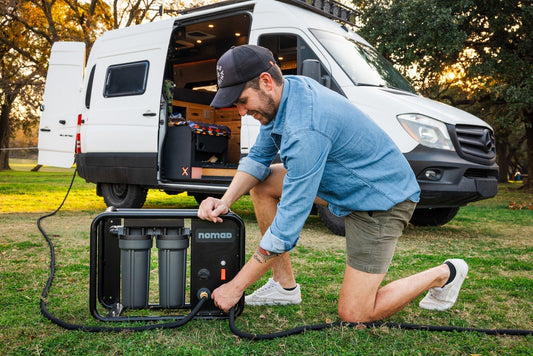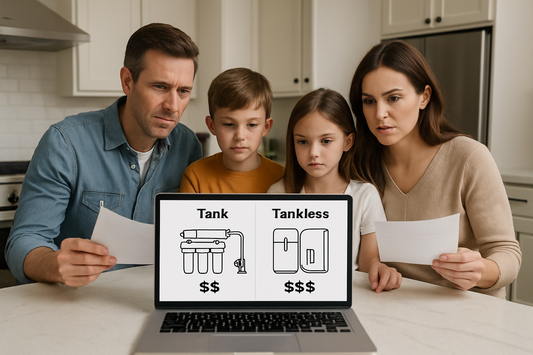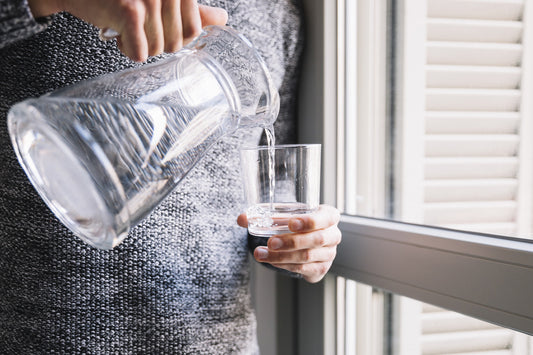If your well water has an off taste, you're not imagining it. Unlike city water that's treated before reaching your tap, well water can contain minerals, bacteria, and contaminants that directly affect taste and safety. The good news? The right well water filter can eliminate these issues completely. Here's how to identify what's causing the problem and choose the exact filter that fixes it.
What Makes Well Water Taste Strange?
Iron and Manganese: The Metallic Culprits
Symptoms: Metallic taste, reddish-brown staining Solution: Iron reduction filters or sediment pre-filtration
Iron levels above 0.3 ppm create that distinctive metallic taste many well owners recognize. Manganese adds a bitter flavor and can cause black staining on fixtures.
Hydrogen Sulfide: The Rotten Egg Problem
Symptoms: Sulfur smell, rotten egg odor Solution: Activated carbon filters or specialized sulfur removal systems
This gas occurs naturally in groundwater and creates an unmistakable smell that makes water undrinkable.
High Mineral Content: Hard Water Issues
Symptoms: Chalky taste, soap scum buildup Solution: Water softeners combined with carbon filtration
Calcium and magnesium aren't harmful but create taste issues and household problems.

Image by chmutphoto
The Right Filter for Your Specific Problem
For Sediment and Particles
A sediment filter for well water should be your first line of defense. These remove sand, silt, and rust particles that cloud water and affect taste. Install a 5-micron sediment filter as a pre-filter before other treatment systems.
For Taste and Odor Issues
Activated carbon filters excel at removing chlorine taste, organic compounds, and many chemicals that affect water flavor. While systems like Pelican water filters were popular choices in the past, newer options like Crystal Quest whole house systems offer enhanced filtration capabilities with easier maintenance.
For Comprehensive Contamination
Reverse osmosis systems remove the widest range of contaminants, including heavy metals, bacteria, and dissolved solids. Consider tankless RO systems for better flow rates and space efficiency.
For Bacterial Concerns
UV sterilization systems neutralize bacteria, viruses, and other microorganisms without chemicals. These work best when combined with sediment pre-filtration.
Choosing Between Single-Stage and Multi-Stage Systems
Single-Stage Approach:
- Best for: One specific problem (iron, sediment, or odor)
- Cost: Lower upfront investment
- Maintenance: Simpler filter replacement schedule
Multi-Stage Systems:
- Best for: Multiple water quality issues
- Cost: Higher initial cost, better long-term value
- Maintenance: Different filters replace on different schedules
Many homeowners start with a basic sediment filter and add stages as needed. This approach lets you address the most pressing issues first while building a comprehensive system over time.

Image by sastock
Installation and Maintenance Considerations
Professional vs. DIY Installation
Most whole house filters require basic plumbing skills, but complex systems benefit from professional installation. Consider your comfort level with shutting off main water lines and making pipe connections.
Filter Replacement Schedule
- Sediment filters: Every 3-6 months
- Carbon filters: Every 6-12 months
- RO membranes: Every 2-3 years
- UV bulbs: Annually
Plan replacement costs into your budget. Buying filters in bulk often reduces per-unit costs significantly.
Modern Alternatives to Legacy Brands
While Pelican water systems built a strong reputation over the years, their reduced availability has led many homeowners to explore newer options. Crystal Quest filtration systems offer comparable performance with updated technology and better customer support.
For those seeking premium options, consider browsing our whole house filter collection to compare features and capabilities across multiple brands.

Testing Your Water First
Before choosing any filter, get a comprehensive water test. This reveals exactly which contaminants you're dealing with and prevents buying unnecessary equipment. Many local health departments offer basic testing, while private labs provide detailed analysis.
Key tests include:
- Bacteria and coliform
- Iron, manganese, and heavy metals
- pH levels and hardness
- Nitrates and sulfates
- Volatile organic compounds (VOCs)
Frequently Asked Questions
Q: How do I know if my well water filter is working properly?
Regular water testing and monitoring filter replacement schedules ensure optimal performance. Most taste and odor issues disappear immediately with the right filter, while contaminant reduction requires laboratory testing to verify.
Q: Can one filter remove all well water contaminants?
No single filter removes everything. Most effective systems use multiple stages—sediment pre-filtration, activated carbon for taste/odor, and specialized filters for specific contaminants like iron or bacteria based on your water test results.
Q: How often should I replace my well water filter?
Replacement frequency depends on filter type and water quality. Sediment filters typically need changing every 3-6 months, while carbon filters last 6-12 months. Heavy contamination shortens filter life significantly.
Q: What's the difference between point-of-use and whole house filters?
Point-of-use filters treat water at one location (like kitchen sink), while whole house systems filter all water entering your home. Whole house systems provide comprehensive protection but cost more upfront.
Getting clean, great-tasting well water doesn't have to be complicated. Start with water testing to identify your specific issues, then choose filters that target those exact problems. With the right system in place, you'll enjoy safe, delicious water straight from your tap.





